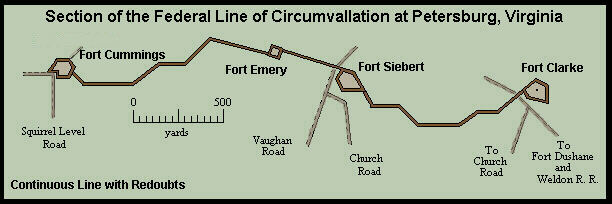
Civil War Field Fortifications
Lines
Lines of field fortifications were linear combinations of field works arranged to increase the defensive endurance of an army holding a position and to protect strategic points from direct assault. Nineteenth century manuals customarily identified two types of lines: continuous lines and lines with intervals. Continuous lines were composed of field works so arranged as to present an uninterrupted entrenched front to an attacking force. Lines with intervals consisted of a series of detached works separated by more or less wide intervals with their faces and salient angles arranged to provide a network of crossing columns of fire through the intervals. Continuous lines were understood as useful when an army was too weak to sustain a powerful counter attack and was therefore compelled to maintain a strict defensive posture. Lines with intervals assumed that the defending army could repel an enemy's assault and answer it with a strong counter attack with the object of decisively defeating and driving off the enemy force.
Continuous lines were further defined in period manuals according to the primary type of field work composing the line and the relative arrangement of those works in sequence within the line. Redan lines consisted of a series of equal sized redans sited at regular intervals which were joined together by curtains to form an uninterrupted parapet and ditch. Tenaille lines were formed by a series of redans joined directly at the flanks without intervening curtains which created a front composed of unbroken salient and re-entering angles. Cremaillere lines were composed of a series of alternating long slanting faces (branches) and short flanks (crotchets) which were directed toward the interior of the line to produce columns of fire across the front of collateral branches. Bastion lines consisted of a series of lunette shaped field works with two faces and two flanks connected by curtains and positioned to provide reciprocal defense for collateral bastions.
Lines with intervals could be composed of two or three distinct lines of field works. The first and most advanced line could be composed of works open at the gorge, such as redans or lunettes, which had the objective of making the initial break in the orderliness of an enemy's attack. The second line could be composed of enclosed works ,such as square redoubts, or lunettes, which covered the rear of the works of the first line and were arranged to provide flanking fire across the faces of the works of the first line. When necessary a third line would be composed of large redans constructed in the form an epaulment (without banquettes) to shelter cavalry from enemy fire while they waited for the signal to advance to counter attack the broken attacking force.
Nineteenth century manuals tended to deal with each type of line separately as distinct forms, but it must be emphasized that in practice all of these distinct forms could be combined in a single line of works as necessary to fortify a particular position. Each distinct form refers exclusively to its outline without regard to the profile or strength of the relief of the parapet and ditch. D. H. Mahan indicated that continuous lines required a reduction of the profile of the parapet as compared to independent and detached field works, but in practice most continuous lines constructed during the Civil War included a series of field works of strong relief that covered salient points which were connected by lighter sections constructed in the manner of rifle pits. Few engineers allowed themselves to be mesmerized by the simple forms outlined in manuals; they usually employed whichever linear form best suited a particular section or point in a line of works. Most lines of field works contained elements drawn from several different prescribed forms and many included redoubts or other enclosed works that were not discussed in manuals as appropriate for continuous lines of works.

Redan Lines Tenaille Lines Cremaillere Lines Bastion Lines Lines with Intervals
Contents Home Page Minor Works Siege Works Permanent Fortifications
Copyright (c) PEMcDuffie 1998